Rate-Dependent Cohesive Models for Dynamic Mode I Interfacial Propagation and Failure of Unidirectional Composite Laminates
Abstract
:1. Introduction
2. Materials and Tests
3. Theories of Cohesive Models
3.1. Bilinear Cohesive Model
3.2. Rate-Dependent Cohesive Models
4. Finite Element Model
4.1. Model Description
4.2. Material Parameters
5. Results and Discussion
5.1. Model Correlation and Prediction of Crack Propagation Length
5.2. Prediction of Crack Propagation Toughness
5.3. Prediction of Cohesive-Zone Length
5.4. Sensitivity of Loading Force
6. Conclusions
- All three models predict well the crack length profiles with average velocity errors within 20%. The exponential model shows relatively larger error compared with that of the logarithmic and power models.
- The predicted crack propagation toughness values of all three cohesive models are much higher than that of experimental results. This indicates that physical mechanism is sacrificed by the phenomenological model in purpose of predicting accurately the cracking behavior.
- In the presented numerical simulation results, the correlation of cohesive-zone length with crack length of DCB specimen are consistent with the results and theory predictions made in the literature [11].
- The peak load of the exponential model is always lower than that of the logarithmic and power models, while in propagation stage, the load force of exponential model is higher than that of the logarithmic and power models especially under high loading rate.
Author Contributions
Funding
Institutional Review Board Statement
Informed Consent Statement
Data Availability Statement
Conflicts of Interest
References
- Fang, G.; Ren, J.; Shi, J.; Gao, X.; Song, Y. Thermal stress analysis of environmental barrier coatings considering interfacial roughness. Coatings 2020, 10, 947. [Google Scholar] [CrossRef]
- Abidin, N.M.; Sultan, M.T.; Hua, L.S.; Basri, A.A.; Safri, S.N. A brief review of computational analysis and experimental models of composite materials for aerospace applications. J. Reinf. Plast. Compo. 2019, 38, 1031–1039. [Google Scholar] [CrossRef]
- Li, Y.; Zhong, J.; Fu, K. Low-velocity impact and compression-after-impact behaviour of flax fibre-reinforced composites. Acta. Mech. Solida. Sin. 2020, 33, 431–448. [Google Scholar] [CrossRef]
- Wu, Q.; Chen, X.; Fan, Z.; Jiang, Y.; Nie, D. Experimental and numerical studies of impact on filament-wound composite cylinder. Acta. Mech. Solida. Sin. 2017, 30, 540–549. [Google Scholar] [CrossRef]
- May, M. Measuring the rate-dependent mode I fracture toughness of composites—A review. Compos. Part. A Appl. Sci. Manuf. 2016, 81, 1–12. [Google Scholar] [CrossRef]
- Kazerani, T.; Zhao, G.F.; Zhao, J. Dynamic fracturing simulation of brittle material using the distinct lattice spring method with a full rate-dependent cohesive law. Rock. Mech. Rock. Eng. 2010, 43, 717–726. [Google Scholar] [CrossRef] [Green Version]
- Dugdale, D.S. Yielding of steel sheets containing slits. J. Mech. Phys. Solids 1960, 8, 100–104. [Google Scholar] [CrossRef]
- Barenblatt, G.I. The mathematical theory of equilibrium cracks in brittle fracture. Adv. Appl. Mech. 1962, 7, 55–129. [Google Scholar]
- Samudrala, O.; Huang, Y.; Rosakis, A.J. Subsonic and intersonic mode II crack propagation with a rate-dependent cohesive zone. J. Mech. Phys. Solids 2002, 50, 1231–1268. [Google Scholar] [CrossRef]
- Nguyen, T.D.; Govindjee, S.; Klein, P.A.; Gao, H. A rate-dependent cohesive continuum model for the study of crack dynamics. Comput. Methods. Appl. Mech. Eng. 2004, 193, 3239–3265. [Google Scholar] [CrossRef]
- May, M.; Lässig, T. Rate-dependent mode I delamination in ballistic composites—Experiment and simulation. Compos. Struct. 2017, 180, 596–605. [Google Scholar] [CrossRef]
- Liu, Y.; van der Meer, F.P.; Sluys, L.J. Cohesive zone and interfacial thick level set modeling of the dynamic double cantilever beam test of composite laminate. Theor. Appl. Fract. Mech. 2018, 96, 617–630. [Google Scholar] [CrossRef]
- Thorsson, S.I.; Waas, A.M.; Schaefer, J.; Justusson, B.; Liguore, S. Effects of elevated loading rates on mode I fracture of composite laminates using a modified wedge-insert fracture method. Compos. Sci. Technol. 2018, 156, 39–47. [Google Scholar] [CrossRef]
- Corigliano, A.; Ricci, M. Rate-dependent interface models: Formulation and numerical applications. Int. J. Solids Struct. 2001, 38, 547–576. [Google Scholar] [CrossRef]
- Musto, M.; Alfano, G. A novel rate-dependent cohesive-zone model combining damage and visco-elasticity. Comput. Struct. 2013, 118, 126–133. [Google Scholar] [CrossRef] [Green Version]
- Giraldo-Londoño, O.; Spring, D.W.; Paulino, G.H.; Buttlar, W.G. An efficient mixed-mode rate-dependent cohesive fracture model using sigmoidal functions. Eng. Fract. Mech. 2018, 192, 307–327. [Google Scholar] [CrossRef]
- Karkkainen, R.L.; Yen, C.F. Dynamic modeling for rate dependent and mode dependent cohesive interface failure analysis. J. Compos. Mater. 2012, 46, 2193–2201. [Google Scholar] [CrossRef]
- May, M.; Hesebeck, O.; Marzi, S.; Böhme, W.; Lienhard, J.; Kilchert, S.; Brede, M.; Hiermaier, S. Rate dependent behavior of crash-optimized adhesives—Experimental characterization, model development, and simulation. Eng. Fract. Mech. 2015, 133, 112–137. [Google Scholar] [CrossRef]
- May, M.; Hesebeck, O. Assessment of experimental methods for calibrating rate-dependent cohesive zone models for predicting failure in adhesively bonded metallic structures. Eng. Fail. Anal. 2015, 56, 441–453. [Google Scholar] [CrossRef]
- Tamrakar, S.; Ganesh, R.; Sockalingam, S.; Gillespie, J.W. Rate dependent mode II traction separation law for S-2 glass/epoxy interface using a microdroplet test method. Compos. Part. A Appl. Sci. Manuf. 2019, 124, 105487. [Google Scholar] [CrossRef]
- Gozluklu, B.; Coker, D. Modeling of dynamic crack propagation using rate dependent interface model. Theor. Appl. Fract. Mech. 2016, 85, 191–206. [Google Scholar] [CrossRef]
- Corigliano, A.; Mariani, S.; Pandolfi, A. Numerical analysis of rate-dependent dynamic composite delamination. Compos. Sci. Technol. 2006, 66, 766–775. [Google Scholar] [CrossRef]
- Corigliano, A.; Mariani, S.; Pandolfi, A. Numerical modeling of rate-dependent debonding processes in composites. Compos. Struct. 2003, 61, 39–50. [Google Scholar] [CrossRef]
- Zhou, F.; Molinari, J.F.; Shioya, T. A rate-dependent cohesive model for simulating dynamic crack propagation in brittle materials. Eng. Fract. Mech. 2005, 72, 1383–1410. [Google Scholar] [CrossRef]
- Makhecha, D.P.; Kapania, R.K.; Johnson, E.R.; Dillard, D.A.; Jacob, G.C.; Starbuck, J.M. Rate-dependent cohesive zone modeling of unstable crack growth in an epoxy adhesive. Mech. Adv. Mater. Struct. 2009, 16, 12–19. [Google Scholar] [CrossRef]
- Yang, T.; Yang, X.; Huang, R.; Liechti, K.M. Rate-dependent traction-separation relations for a silicon/epoxy interface informed by experiments and bond rupture kinetics. J. Mech. Phys. Solids 2019, 131, 1–19. [Google Scholar] [CrossRef]
- Lißner, M.; Alabort, E.; Cui, H.; Pellegrino, A.; Petrinic, N. On the rate dependent behaviour of epoxy adhesive joints: Experimental characterisation and modelling of mode I failure. Compos. Struct. 2018, 189, 286–303. [Google Scholar] [CrossRef] [Green Version]
- Marzi, S.; Hesebeck, O.; Brede, M.; Kleiner, F. A rate-dependent cohesive zone model for adhesively bonded joints loaded in mode I. J. Adhes. Sci. Technol. 2009, 23, 881–898. [Google Scholar] [CrossRef]
- May, M. Numerical evaluation of cohesive zone models for modeling impact induced delamination in composite materials. Compos. Struct. 2015, 133, 16–21. [Google Scholar] [CrossRef]
- Fernandes, R.L.; Campilho, R.D.S.G. Numerical evaluation of dissimilar cohesive models to predict the behavior of Double-Cantilever Beam specimens. Procedia. Struct. Integr. 2016, 1, 42–49. [Google Scholar] [CrossRef]
- Salih, S.; Davey, K.; Zou, Z. Rate-dependent elastic and elasto-plastic cohesive zone models for dynamic crack propagation. Int. J. Solids Struct. 2016, 90, 95–115. [Google Scholar] [CrossRef]
- Liu, H.; Meng, X.; Zhang, H.; Nie, H.; Li, Y. The dynamic crack propagation behavior of mode I interlaminar crack in unidirectional carbon/epoxy composites. Eng. Fract. Mech. 2019, 215, 65–82. [Google Scholar] [CrossRef]
- Benzeggagh, M.L.; Kenane, M. Measurement of mixed-mode delamination fracture toughness of unidirectional glass/epoxy composites with mixed-mode bending apparatus. Compos. Sci. Technol. 1996, 56, 439–449. [Google Scholar] [CrossRef]
- Turon, A.; Camanho, P.P.; Costa, J.; Renart, J. Accurate simulation of delamination growth under mixed-mode loading using cohesive elements: Definition of interlaminar strengths and elastic stiffness. Compos. Struct. 2010, 92, 1857–1864. [Google Scholar] [CrossRef]
- Low, K.O.; Teng, S.M.; Johar, M.; Israr, H.A.; Wong, K.J. Mode I delamination behaviour of carbon/epoxy composite at different displacement rates. Compos. Part. B Eng. 2019, 176, 107293. [Google Scholar] [CrossRef]
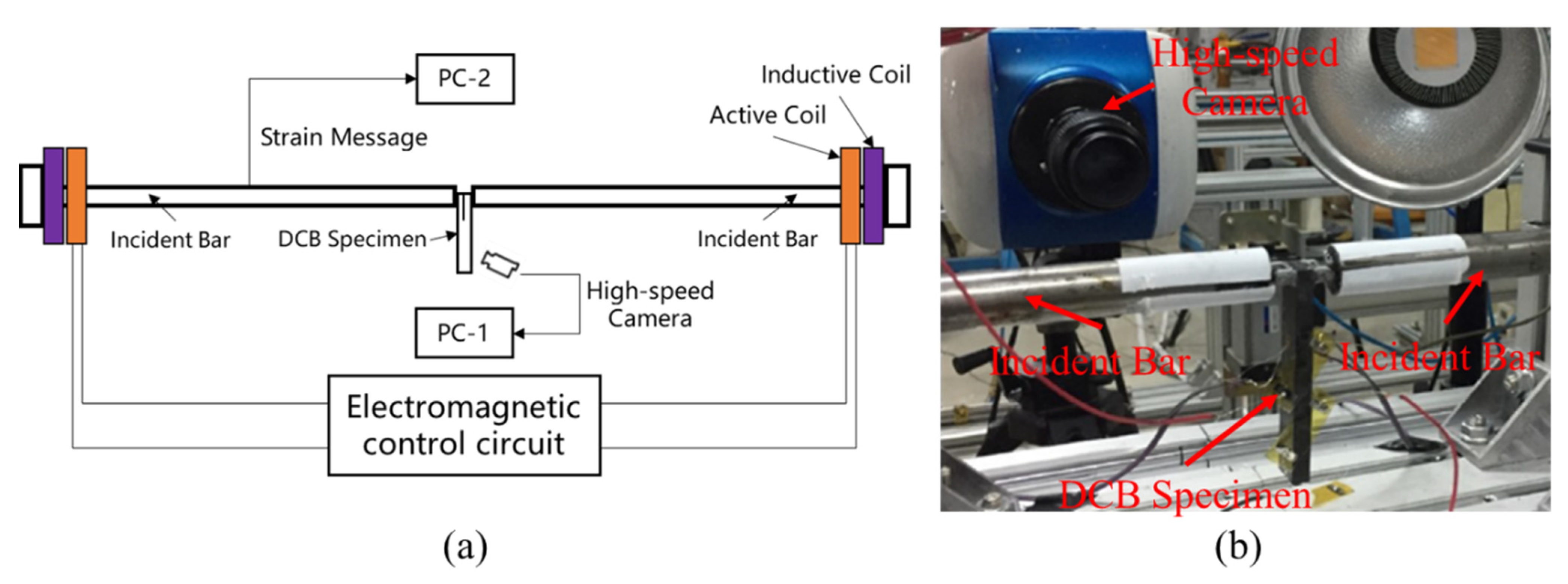

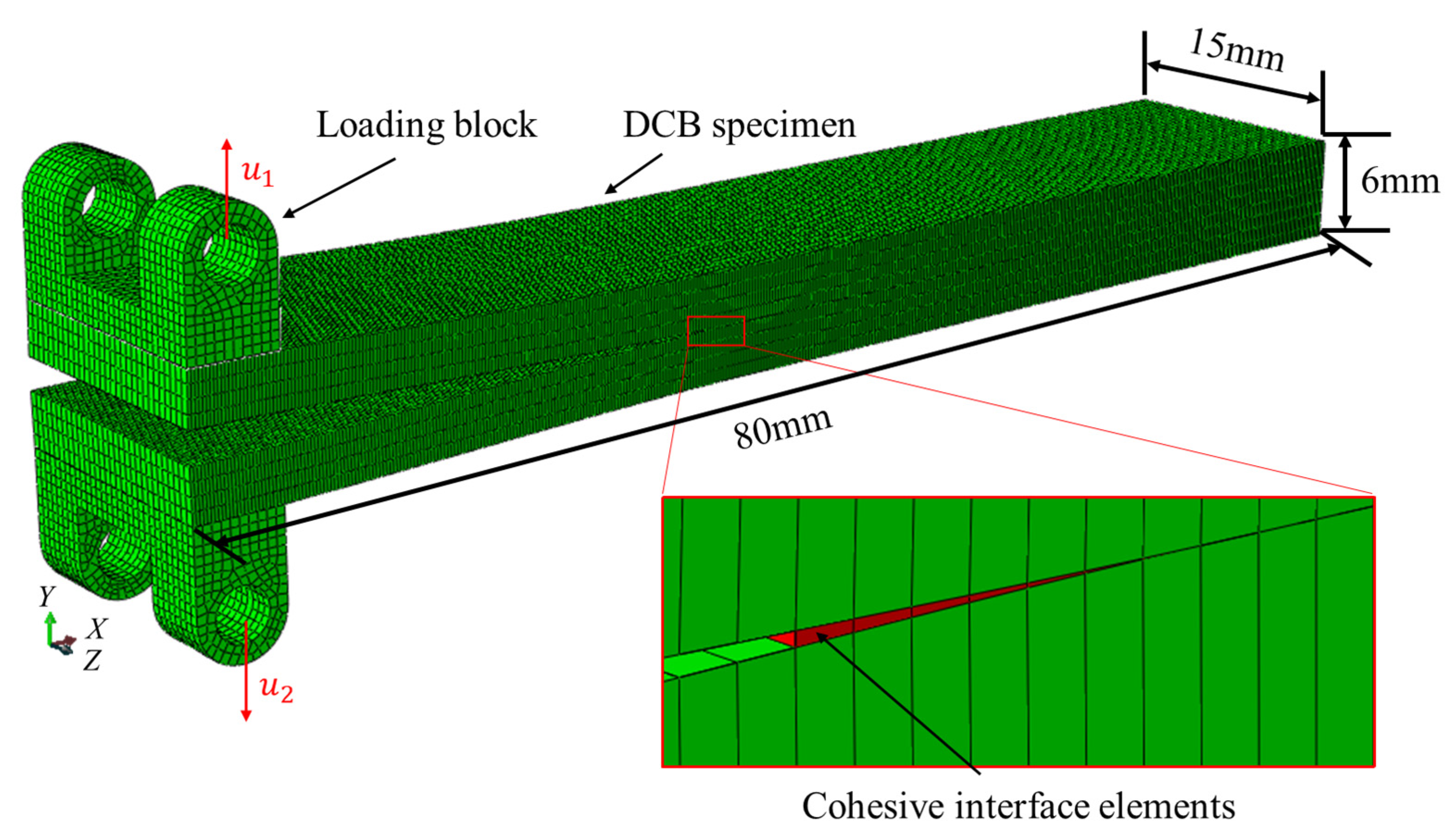
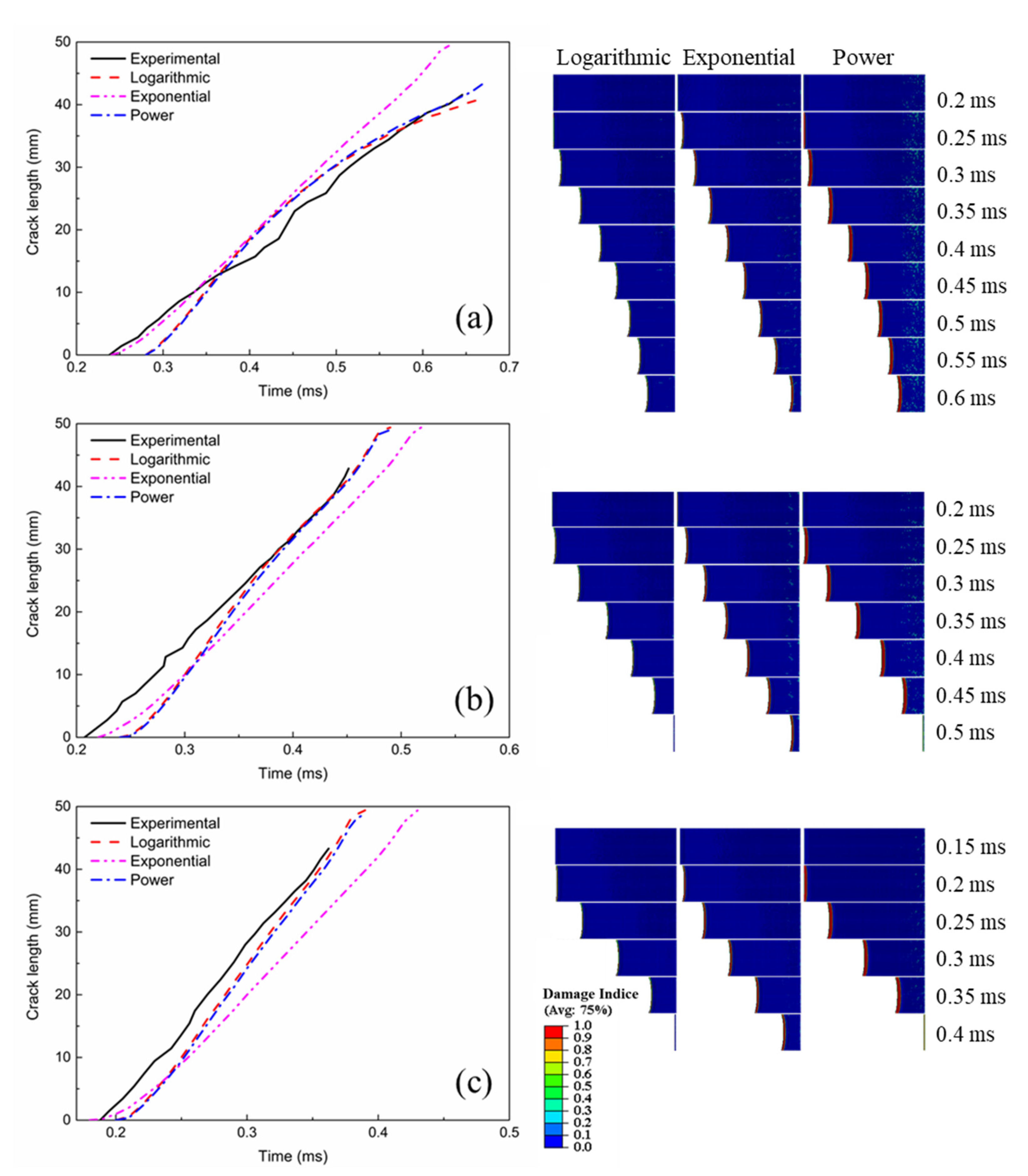

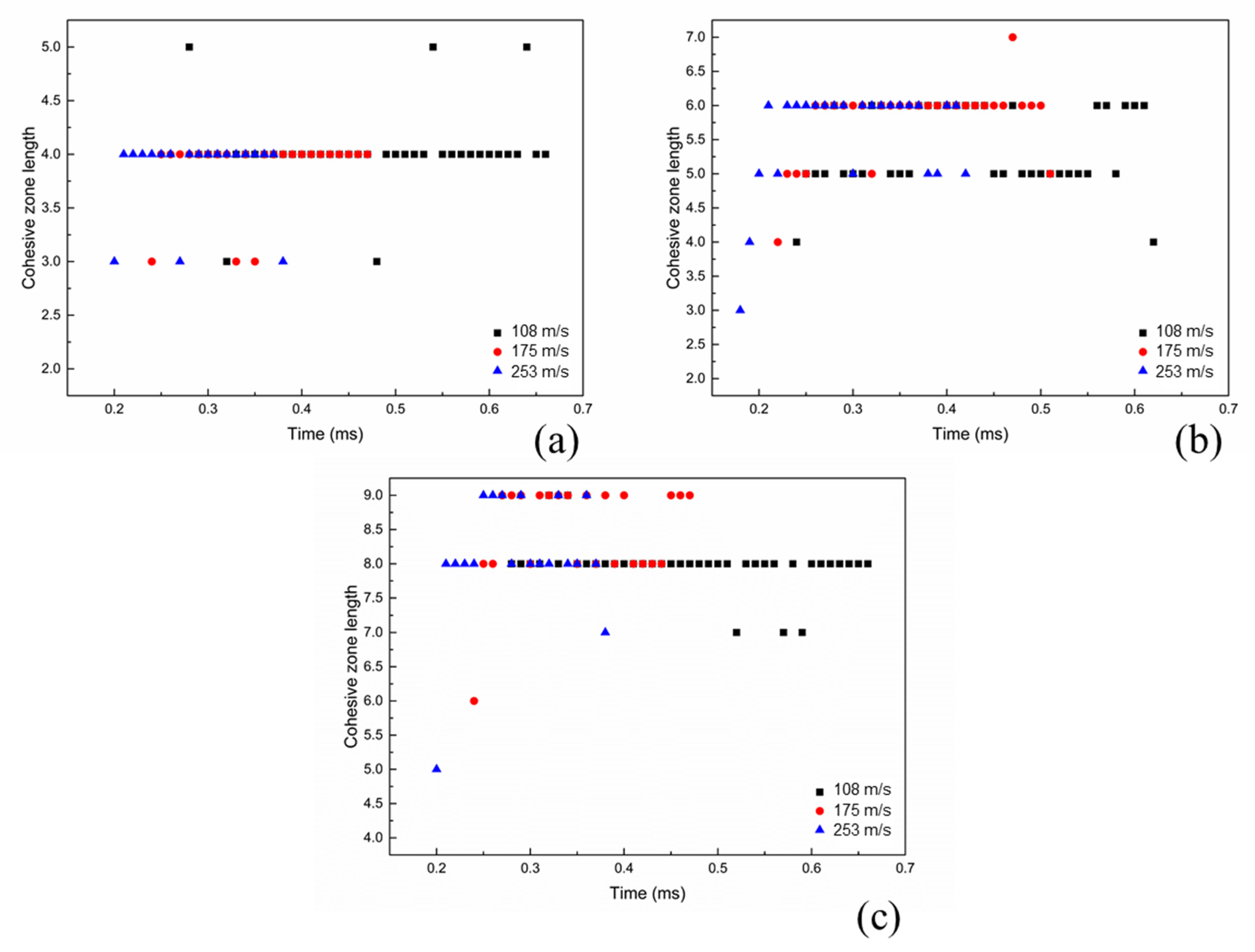
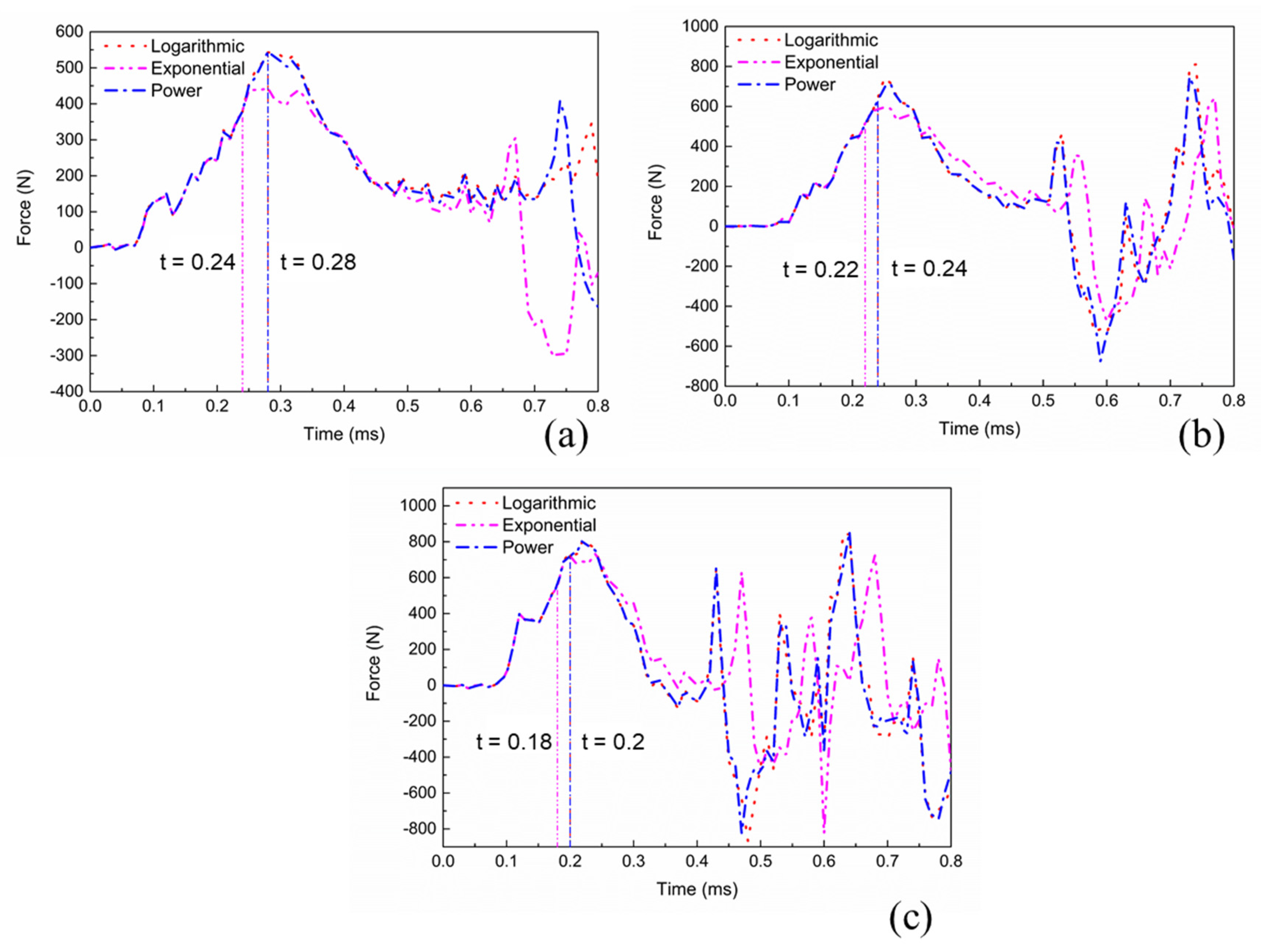
| Density | ρ = 1522 kg/m3 |
| Young’s modulus | E11 = 127 GPa, E22 = E33 = 8.4 GPa G12 = G13 = 3.7 GPa, G23 = 3.0 GPa |
| Poisson’s ratio | ν12 = ν13 = 0.3, ν23 = 0.4 |
| Mode I and mode II stiffness E | 5 × 105 N/mm3 | |
| Quasi-static mode I and mode II strength | 80 MPa | |
| Quasi-static mode I fracture toughness | 0.43 mJ/mm2 [32] | |
| Quasi-static mode II fracture toughness | 1.25 mJ/mm2 [32] | |
| Mixed-mode exponent η | 2.284 [12] | |
| Logarithmic model | Reference separation opening rate | 20 mm/s [12] |
| Rate-dependent coefficient | 0.22 [12] | |
| Rate-dependent coefficient | 0.5 | |
| Exponential model | Reference separation opening rate | 4500 mm/s |
| Rate-dependent coefficient k | 10 | |
| Power model | Reference separation opening rate | 20 mm/s |
| Rate-dependent coefficient n | 0.2 | |
| Experimental (m/s) | Logarithmic Model | Exponential Model | Power Model | |||
|---|---|---|---|---|---|---|
| Velocity (m/s) | Error | Velocity (m/s) | Error | Velocity (m/s) | Error | |
| 108 | 111 | 2.78% | 129 | 19.44% | 117 | 8.33% |
| 175 | 208 | 18.86% | 169 | −3.43% | 207 | 18.29% |
| 253 | 276 | 9.09% | 211 | −16.60% | 272 | 7.51% |
Publisher’s Note: MDPI stays neutral with regard to jurisdictional claims in published maps and institutional affiliations. |
© 2021 by the authors. Licensee MDPI, Basel, Switzerland. This article is an open access article distributed under the terms and conditions of the Creative Commons Attribution (CC BY) license (http://creativecommons.org/licenses/by/4.0/).
Share and Cite
Zhang, C.; Liu, H.; Cao, J.; Zhang, C. Rate-Dependent Cohesive Models for Dynamic Mode I Interfacial Propagation and Failure of Unidirectional Composite Laminates. Coatings 2021, 11, 191. https://doi.org/10.3390/coatings11020191
Zhang C, Liu H, Cao J, Zhang C. Rate-Dependent Cohesive Models for Dynamic Mode I Interfacial Propagation and Failure of Unidirectional Composite Laminates. Coatings. 2021; 11(2):191. https://doi.org/10.3390/coatings11020191
Chicago/Turabian StyleZhang, Chenxu, Huifang Liu, Junchao Cao, and Chao Zhang. 2021. "Rate-Dependent Cohesive Models for Dynamic Mode I Interfacial Propagation and Failure of Unidirectional Composite Laminates" Coatings 11, no. 2: 191. https://doi.org/10.3390/coatings11020191






